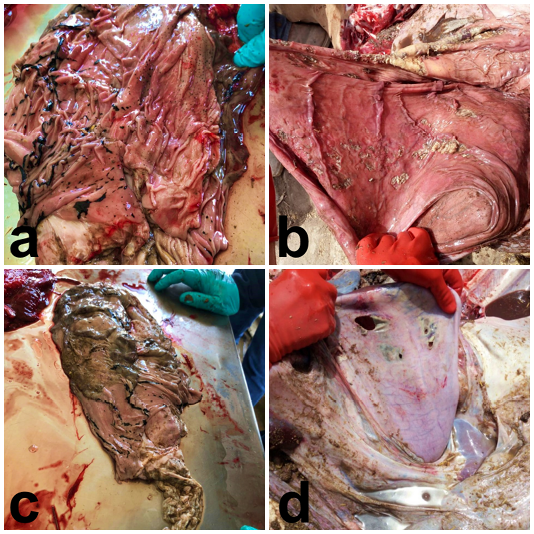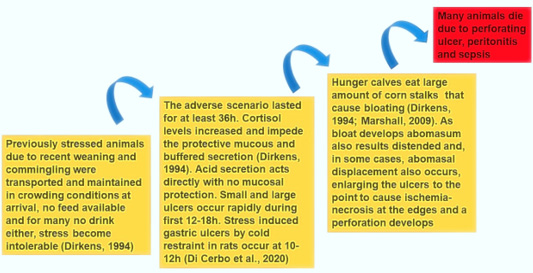Journal of Animal Health and Production
Case Report
The Welfare Absence Means Pathology: An Example of Abomasal Ulcers and Fatal Peritonitis in Feedlot Calves
Cecilia Ramírez-Hernández1, Luis Jorge García-Márquez2, Johnatan Alberto Ruiz-Ramírez3, Rafael Ramírez-Romero4*
1Universidad Autónoma de Nuevo León, Departamento de Patología, Facultad de Medicina Veterinaria y Zootecnia, Campus Ciencias Agropecuarias. Av. Francisco Villa s/n, Ex-Hacienda El Canadá, Gral. Escobedo, N.L. México, C.P. 66050; 2Centro Universitario de Investigación y Desarrollo Agropecuario (CUIDA), Facultad de Medicina Veterinaria y Zootecnia, Universidad de Colima, México; 3Facultad de Medicina Veterinaria y Zootecnia, Universidad de Colima, Tecomán, México; 4Private Consultant in Veterinary Pathology and Animal Health.
Abstract | A mortality outbreak in calves entered directly in a feedlot was reported. Mortality reached 24% in three days and morbidity was close to 60%. Animals arrived in feedlot three to four days before during the weekend and overwhelmed the expected entrance in 300%. Upon arrival the animals (among 7 to 8 months old, weighing 180-200kg) were received in a hallway employed to provisionally keep animals before assignment in a pen. The hallway was crowded to the point that the animals were restrained and many of them were unable to reach the sole drinker. No food was provided. The next Monday morning, animals were routinely processed (almost 60 h after) and assigned to a pen with drinkers and corn straw in feeders. However, that day many animals suddenly died (90), and many more (114), succumbed during the following two days (204/850=24%). The post mortem exams registered bronchopneumonia and abomasal ulcers, many of them (62 cases/204=30.4%) perforated causing peritonitis, in absence of severe bronchopneumonia. At first time, abomasal ulcers were considered a new syndrome with suspected clostridial disease or poisoning. A proposal pathogenesis established an initial intolerable stress causing ulcers and subsequently, the hunger forced aggressive consumption of straw corn stalks provoking ruminal bloat with distended (or displaced) abomasum, resulting in ischemic necrosis of the ulcer edges with perforation and fatal peritonitis.
Keywords | Feedlot calves, Stress, Abomasal ulcer, Animal welfare, Diagnostic pathology
Editor | Asghar Ali Kamboh, Sindh Agriculture University, Tandojam, Pakistan.
Received | March 15, 2021; Accepted | June 08, 2021; Published | August 25, 2021
*Correspondence | Rafael Ramírez Romero, Consultor Privado, Patología Diagnóstica Veterinaria. Gral. Escobedo, México. C.P. 66050; Email: raramirez@prodigy.net.mx
Citation | Ramírez-Hernández C, García-Márquez LJ, Ruiz-Ramírez JA and Ramírez-Romero R (2021). The welfare absence means pathology: An example of abomasal ulcers and fatal peritonitis in feedlot calves. J. Anim. Health Prod. 9(3): 331-334.
DOI | http://dx.doi.org/10.17582/journal.jahp/2021/9.3.331.334
ISSN | 2308-2801
Copyright © 2021 Ramírez-Hernández et al. This is an open access article distributed under the Creative Commons Attribution License, which permits unrestricted use, distribution, and reproduction in any medium, provided the original work is properly cited.
INTRODUCTION
The high demand for bovine beef has increased the tendency to intensify the cattle fattening system in outdoor pens. The feedlot cattle system in the USA, Canada, Mexico, and other countries in America, as well as in Australia and South Africa is a good example of the increase in this intensive beef production system. The goal is to yield more weight and higher quality beef in young cattle (Grandin, 2016; Vale et al., 2019). In Mexico, calves arriving to the feedlots at 220 kg live weight or lighter are sent to abattoirs with over 500 kg approximately, six months later (Peel et al., 2011). The system requires a grain-based diet (mostly corn or other cereal sub products) in higher proportions (≥85%) in finishing diets (Peel et al., 2011).
Bovine respiratory disease complex (BRDC) is considered the most important cause of morbidity and mortality in feedlots worldwide (Earley et al., 2017; Panciera and Confer, 2010). Therefore, bronchopneumonia is a common diagnosis in postmortem exams in feedlots (Fulton et al., 2009; Ramírez-Romero et al., 2012). Several factors including, recent weaning, commingling of calves with different origins and, dehydration have been identified as main stressors (Early et al., 2017; Panciera and Confer, 2010). Furthermore, dissemination of some viral infections and subsequent opportunistic lower respiratory tract bacterial infections results in high feedlot morbidity and mortality (Loneragan et al., 2001; Ramírez-Romero et al., 2012). This scenario has been identified since the middle of the last century and still results the main problem in feedlots worldwide (Early et al., 2017; Loneragan et al., 2001; Panciera and Confer, 2010). The stressful conditions particularly during gathering, transporting, and receiving processes at feedlot, are probably impossible to avoid, but diminishing those as much as possible must be the goal in this intensive beef production system. Sometimes, however, unusual receiving errors such as those described in this report, cause even worse losses because the system does not tolerate addition of other stressful conditions.
Case report
A visit by request in a feedlot cattle enterprise with about 45,000 animals was carried out in March 2018. The feedlot localizes in the Huasteca region (humid subtropical climate region), San Luis Potosi, Mexico. The main problem referred to calves recently introduced. In these animals, the veterinarians gave a diagnosis of bronchopneumonia with ulcerative abomasitis in all the fatalities. The latter was considered unusual with presumption of clostridial disease, or intoxication. Furthermore, they noted that in 54 cases of perforated abomasal ulcers with peritonitis, not significant bronchopneumonia was encountered. This was confirmed in the post mortem exams carried by the authors (8 cases with perforated ulcers). During an irrelevant conversation, the reception team mention a previous entrance of several trucks with animals during the weekend. Therefore, most of the animals that succumbed arrived at feedlot three to four days before during the weekend and, overwhelmed the expected entrance in 300%. The normal intake is between 180-300 animals, but in this case 850 calves were received from Friday afternoon to Saturday evening. The calves were downloaded and maintained in a hallway employed as provisional animal reception before process and assignment in a pen. This is the routine instruction to the guards who receive cattle during weekend. The reason for the unusually higher introduction to the feedlot was a great opportunity of buying, at cheaper price, recently weaned light weight calves at the zone and farther. This arrangement was carried out not by the acquisitions department, but directly by the owner, which sporadically has happened.
Few cases (18) were still present during the technical visit, the outbreak was in decline. However, in the few postmortem exams the previous findings were confirmed. Ulcers with different severity were widespread mainly in the fundus of abomasum (Figure 1). Samples for histopathology and toxicology were collected. However only histopathology was carried out because antecedents resulted enough to conclude the pathogenesis of the condition. Microscopically, the morphologic diagnosis was: abomasitis fibrinonecrotic with mural and transmural ulcer extension, vasculitis, and thrombosis, severe, acute, focally extensive. The presence of bacterial colonies was frequent but not related to the lesions. The proposed pathogenesis is depicted in Figure 2.

Figure 1: Calves, abomasa, different degrees of lesion severity. (a) several ulcers in fundus are evident, some lineal on the folia and other irregulars with blood clots on the surface. Microscopically, few were transmural and reached the serosa provoking focal peritonitis but not rupture. These lesions could be included as grade 2 (Marshall, 2009). (b), other ulcers were covered by fibrinous exudate (diphtheric plaque); histologically these lesions reached muscular layer wall but not the serosa (grade 1). (c) In some cases, the grade 2 ulcerative abomasitis included a profuse haemorrhage forming large blood clots within the abomasum. In this case the clot is on the upper left corner. (d) In some necropsies the abomasal content was spread throughout the peritoneal cavity leading to mild and diffuse fibrinous inflammation within the abdominal cavity (grade 4; focal peritonitis is included as grade 3). In all cases mild to severe bronchopneumonia was recognized (grossly and microscopically), except in most cases of grade 4, abomasal perforating ulcers, in which bronchopneumonia lesions were inconclusive, because limited extension (≤ 30%).
RESULTS AND DISCUSSION
Animal welfare is a worldwide action that demands an integrated wellness state for animals. For outdoor feedlots, Grandin (2016) mentioned that muddy pens, heat, and humid climate and, problems derived from handle large number of animals, are opportunities to improve in most feedlots worldwide. On the other hand, access to clean water, adequate diets, as well as providing comfortable pens for upcoming calves, are obvious requirements, but scenarios vary much (Grandin, 2016). Nonetheless, the latter points were the main fails to cope with an unusual large number of calves arriving in this case. This inexcusable fault provoked intolerable stress in the received animals. The adverse conditions continued with an inadequate diet composed by a straw of coarse corn stalks. This type of roughage has been associated with development of abomasal distention and ulcers in calves (Dirksen, 1994; Marshall, 2009). Probably, have had providing with a good quality forage in feeders could have diminish the mortality in this case.
Several infections and parasitic diseases may affect calves at entering feedlot (Martin et al., 1980). However, apart from bronchopneumonia no other conditions have been identified as relevant cause of high mortality outbreaks during the initial fattening term (Loneragan et al., 2001). The abomasal ulcers are not always fatal and occur frequently in feedlot yearlings and dairy cows (Jensen et al., 1976; Palmer and Whitlock, 1984). However perforating ulcers are mostly fatal (Jensen et al., 1976). In feedlot, fatal abomasal ulcers are more frequently encountered in calves entering the feedlot (Jensen et al., 1976). Among the main factors related include coarse feed, stressor factors, nutritional deficits, and infectious disease (Mills et al., 1990; Dirksen, 1994; Marshall, 2009). Therefore, avoiding stressing factors during reception of light weight cattle to the feedlot is the message highlighted here. Furthermore, any abnormal increase of upcoming calves to enter the feedlot require previous notice to adapting and adjustment the facilities and assign the personnel to receive the entrance avoiding the problem herein described. In the present case, improvement of facilities now includes four well designed downloading ramps that lead to the corresponding reception pens.
Acknowledgments
The authors thanks to the feedlot manager, personnel involved in the cattle reception and cattle pen riders, as well as the necropsy helpers.
Novelty Statement
This study is a novel pathogenesis proposal demonstrating that calves under severe and prolonged stressful conditions may develop pathology that might cause death in calves entering feedlots. Adaptation of receiving processes are recommended.
Author’s Contribution
CRH, LJGM and RRR visited the ranch and performed the post mortem studies. JARR, LJGM and CRH reviewed the histopathological slides CRH and JARR classified the lesions and taked pictures. RRR proposed the pathogenesis and made the first draft. CRH was responsible for the final draft.
Conflicts of interest
The authors have declared no conflict of interest.
REFERENCES







